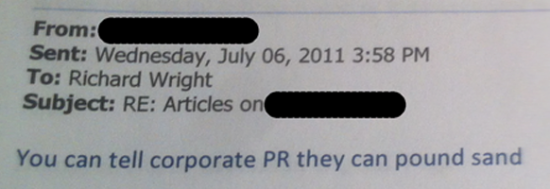- Your website is good for only three things Unless there's some business functionality built into your website, users are...
Why having a website is not enough




Unfortunately, website managers will sometimes “comp” wireframing for their clients, hoping (and praying) the contract gets signed following this initial phase. They shouldn’t. Wireframing requires website managers to charge the client an up-front fee before the final graphic designs and coding begins. A client is often reticent to pay for this wireframing because it’s far from a finished product, merely the specification for the final product.
The wireframe is the draft of the website, allowing the website manager to define the infrastructure for presenting content and functionality within a hierarchy that will ensure users can easily find the information that’s most important on the final website. Architects do a similar thing when they create a building, drafting and then producing a blueprint that will lead to their creation. Likewise, website managers create screenshots from wireframes. Our clients need to be educated on the importance of this draft for their website construction, and that this crucial part of the process is portable and patentable. It’s not a stretch to call a good wireframe the secret formula to a successful website.
For this reason it’s crucial that you communicate all the steps involved with building a website before any work begins. Wireframing may be a single component in what goes into building a successful website, but it’s the most important one.
WIREFRAMING IS THE SECOND – AND MOST IMPORTANT – STEP TO BUILDING A SOLID WEBSITE:
- Website Analysis and Conceptualization
Using a spreadsheet, list all the aspects of the website that will need to be available, including what information will be available on the website, what functionality will need to exist and how the website will be supported by various departments from technical, marketing, communications, legal and customer servicing personnel. Existing or proposed naming and branding (i.e., colors, logos, fonts, backgrounds, borders) are also listed within this section. The technical infrastructure is documented for the website, including server allocation, DNS planning, coding tools and technology (i.e., HTML, PHP, Javascript, etc.), database requirements, and third-party modules and content management systems (i.e., Word Press, eCommerce, Merchant Accounts, etc.). Establish a release schedule and timeline for implementation, including feedback windows and disclaimers on roadblocks that could present themselves during the final roll out. Allow 2 week for this process to be completed.- Wireframing
Before proceeding with wireframing, the client should sign a contract covering this expense. Wireframing is where the website manager drafts workflow showing how the website will function. Navigational trees and flow charts dominate wireframing methodology in addition to the visual layout for where information will appear on each page, important information prioritized on top, front a center. Keep in mind there is no branding within this phase, only the skeleton for how the website will act, including sales funnels, transactions, information transfer and customer conversion. Allow 2-4 weeks for this process to be completed.- Design Screenshots (optional)
Once the client understands and signs off that all aspects of the wireframe are correct, the design process can begin. A good wireframe often negates the need for screenshots. But screenshots are helpful blueprints based on the drafts, screenshots that come close to representing the final look and feel for branding, navigation and the visual synthesis. Most website managers use Photoshop or Illustrator for these. If existing templates are being utilized, the customization of these templates will be done and presented to the client for approval. Screenshots often make it easier to receive legal and compliance sign-off for the entire project put forth. Allow 1 week for this process to be completed.- Infrastructure Implementation
New websites are always built on testing servers that can later be published. Beta websites should be password secured and not available to the public, both for legal and proprietary reasons. Subcontractors are hired and servers leased to begin this implementation. Here is the final step before the actual construction of the website begins. Allow 1 week for this process to be completed.- Construction of Website
Coding and construction based on previous plans. Unless a phased approach is used, do not give a “sneak peak” to the client. Allow 1-2 weeks for this process to be completed.- Tendering and Negotiations
Your duty as the manager is to stick to the agreed timeline for the client that includes what they can expect to see in the course of the building phase. Website managers should be prepared to broker and schedule domain name changes, establish mirror servers, coordinate release schedules and activate credit card merchant accounts. Once delivered, the website manager will revise the website according to original revision agreements (make sure they are there!), charging additional fees when revisions exceed specifications.
For more information on wireframing, Winnie Lim has outlined a “Beginner’s Guide” that also suggests various methods for coming up with your own process.

Have you ever wondered what happened to those Blue Bird school buses we grew up riding? One by one, individual Latin Americans bought more than 1 million of the retired kid haulers over the past 20 years, rebuilding their engines in makeshift garages and painting them vivid colors to attract a new type of customer – the working class tracking to the super highways of Central and South America to make business.
Before having kids I traveled through Guatemala, Belize, Honduras and Nicaragua via these “chicken buses”. Outfitted with rooftop luggage rails to boost their utility, each bus had a driver and ayudante, or helper, who conduct transit routes from one large city to another, stopping frequently between towns and villages. The ayudante hangs out the door waving and shouting destinations, making change and helping each passenger aboard while loading and unloading produce, grains, textiles and all manner of fowl. While not very comfortable over long distances, this third world transit system is extremely efficient and prolific, beyond the control of bureaucrats and corrupt governments.
Our first world increasingly depends on the Internet to drive our commerce needs for the working class. While large corporations provide the majority of transactional services, smaller business needs can often be serviced only through the efforts of micro initiatives led by a freelancer or small business, sometimes called a microbusiness. Microbusinesses are defined by the U.S. Government as organizations with less than five employees, small enough to require little capital ($35,000 or less) to get started. Microbusiness owners are the people who refer to themselves as soloists, independents, consultants, craftsmen, artists, musicians, freelancers, free agents, and self-employed people. The majority of these companies are one-person enterprises and operate out of their homes – many have part-time help from a family member or friends. Most are creative and adaptive, reusing ideas and protocols to serve a niche market.
Rather than focus time and energy on reinventing technology, the MicroBus will reuse software and contract discount modular services to save money. A Word Press website, for instance, with added Woo Commerce purchase functionality makes a lot more sense than a custom PHP eCommerce front end.
Despite grumblings that bigger corporations have boxed out the small business man and woman, we find plenty of space, the client base for Internet initiatives growing exponentially year after year. Do any search on Google and you’ll see the millions of websites delivering services to the working classes, one MicroBus at a time.

When people ask me about my favorite writer I tell them about an eBay Listing for a Subaru. The seller was down on his luck, uneducated and unemployed, his car selling on eBay to make mortgage payments on his house. His motorcycle would be his only transportation thereafter. The listing he wrote on eBay remains one of the best pieces of writing I’ve read, beginning with his first sentence, “… I bought this car brand new in Oct. 2002, and have driven it carefully, though sometimes quickly, ever since.” His story goes on like a memoir about a lost lover from times gone by: “I’ve driven this thing through absolutely ridiculous amounts of snow, no problem. Snow to the headlights? Plow it with the front bumper. Plowed into a parking space? Select reverse, engage clutch. Road covered with wet leaves? Drive as if it’s a sunny, dry day …. For a while there, it was doing the work of a pickup truck, and on several occasions got me out of spots from which big 4WD pickups were failing to extract themselves. Seriously, I once got up a hill that a plow truck couldn’t get up.”
Good writing is rare. Humorous writing rarer. If you’re not funny, nostalgia goes far with readers and will make up for lack of experience or talent. Remember, facts are boring and good story telling has nothing to do with a college degree. The best stories are ones that provide facts riddled with contextual heart-felt stories that support an argument.
When new bloggers approach me with the question of what it takes to write a good story, I send them the below template:
By continuing to use the site, you agree to the use of cookies. more information
The cookie settings on this website are set to "allow cookies" to give you the best browsing experience possible. If you continue to use this website without changing your cookie settings or you click "Accept" below then you are consenting to this.